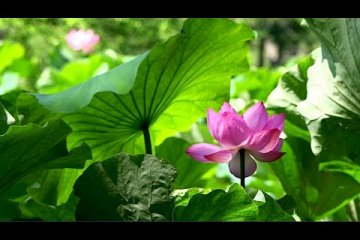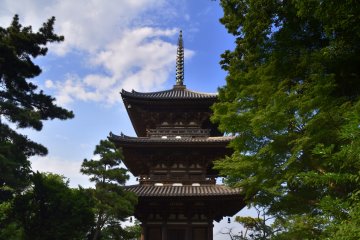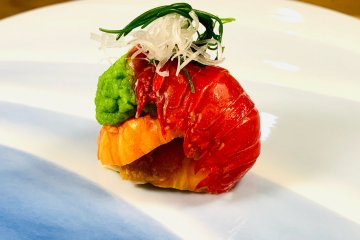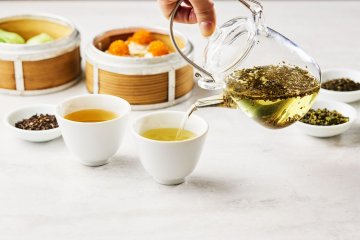

In 1859, when the port of Yokohama opened to foreign trade, silk was the country's largest export. In 1909, Japan was the world's premier silk supplier, serving markets such as the United States and Europe.
Sankeien was built by Hara Sankei, a great entrepreneur who produced and traded silk in Yokohama. In the early 1900s, he used some of his wealth to create a Japanese garden over the course of about 20 years.
The Sankeien covers approximately 175,000 square meters and extends over three valleys along the coast. It consists of an outer garden that has been open to the public since 1906 and an inner garden that was originally kept private for Sankei's personal use. Seventeen historic structures that have been relocated from Kyoto, Kamakura and other locations have been brought into harmony with nature over the four seasons to present great landscapes.


산케이엔 정원은 일반적으로 일본에서 가장 아름다운 곳 중 하나로 알려져 있다. 여름에 멋진 분홍색 연꽃들이 활짝 핀 봄은 가을의 아름다움으로 가득 차 있어, 겨울에는 사뭇 다른 모습을 하고 있어 겨울에 방문하는 것을 꺼려하는 사람들이 있다. 하지만 눈 오는 날에 이곳에 방문하는 것은 정말 운이 좋은 것이였다.




요코하마의 산케이엔 정원에 있는 아름다운 연꽃 연못을 방문해 보시길 바란다. 이른 아침에 오셔야 조용하고 평화로운 분위기에서 연꽃 체험을 즐기기 가장 좋다.
![산케이엔 반딧불이의 저녁 [종료] 산케이엔 반딧불이의 저녁 [종료]](https://a0.cdn.japantravel.com/photo/4877-31692/360x240!/kanagawa-sankeien-firefly-night-31692.jpg)
가나가와 현 요코하마 시의 산케이엔(三渓園)가든은 반딧불이를 감상하기에 좋은 장소이므로, 꼭 추천하고 싶은 곳입니다.

커플 또는 그룹(최대 12명)에 이상적인 Masago는 맛있고 예술적인 매력적인 가이세키 요리를 제공합니다. 본연의 맛을 유지하면서 세계 각국의 맛을 더한 일식 요리를 맛볼 수 있습니다.

Peace Cafe는 맛있고 다채로운 채식 메뉴를 제공한다. 이 하와이식 카페는 절대 당신을 실망 시키지 않을 거다. 타코 샐러드, 두부로 만든 돈까스, 야채 카레를 맛볼 수 있다.

미스 카사블랑카에서 애프터눈 티로 중국차, 딤섬, 시우마이, 만두를 즐겨보세요. 가나가와현의 고급 중화요리를 맛볼 수 있는 시크하고 편안한 캐주얼 중식당입니다.

Known in Japanese as ‘Negishi Shinrin Koen’, this is one of the largest parks in Yokohama with a surface area covering over 1800 square meters. Originally built as a racing track in 1867, it was home to the first western style horse racing in Japan. However, after the Second World War it was redeveloped into a golf course by occupation forces. Its fortunes were changed once again in 1977 when it was officially opened by Yokohama city as Negishi Forest Park.

Masobyo Temple (媽祖廟), also called Ma Zhu Miao, is located in Yokohama’s Chinatown. The young Taoist temple, which opened relatively recently in 2006, enshrines Mazu, the Chinese Goddess of the Sea. Despite its young age, the temple exudes ancient spirituality older than its years. The structure has a geometrical base and is decorated with blue, green, red, and gold detailing. A massive gate welcomes visitors and worshippers alike and is connected to the main temple with a line of red lanterns. Inside Masobyo, a statue of Mazu is cloaked in vibrant attire and wearing an imperial headdress, symbolizing her godly status. The interior is equally as impressive as the outside with exquisite designs covering every surface. Worshippers commonly go to the temple to pray for safe travels since, historically, sailors and fishermen would pray to the goddess for calm seas during their journeys. History of Mazu: Goddess of the Sea As a human, Mazu was born in the tenth century and named Lin Mo. According to legend, she was gifted with supernatural abilities, such as predicting the weather, calming storms, and experiencing visions. She dedicated her life to the teachings of Tao and ascended to the heavens at age 28 as a goddess. Mazu has two demon bodyguards, Qianliyan and Shunfenger. Both demons vowed to protect Mazu after failing to defeat her in combat for her hand in marriage. Inside Masobyo, statues of the demon guardians stand to the left and right of Mazu. One, colored red, is positioned in a listening pose with his hand to his ear, while the green colored one is diligently watching, with eyes that seem to scan the temple. Today Worshippers visit Masobyo to pray to Mazu for safe travels, as well as general health and safety. The temple is also a popular spot for tourists due to its traditional architecture and cultural significance in Chinatown. Of course, Mazu’s affinity for keeping travellers safe is appealing to tourists as well. Masobyo’s temple staff are extremely helpful and more than willing to teach visitors the appropriate methods of worship. Individuals who want a closer look at Mazu’s statue are required to buy incense sticks, which they place in five burners. After lighting the incense sticks, they should bow in respect. During New Years, the temple becomes crowded with people participating and watching the festive displays.

Yokohama Chinatown, also known as Yokohama Chukagai, is Japan’s largest Chinatown. An enclave of Chinese shops and restaurants has stood in this section of Yokohama since the port city was opened to international trade in 1859. The entrance to Chinatown is marked by four intricate and colorful gates, which represent the four directions in Chinese tradition. Each gate is associated with a different mythological animal an additional five gates stand within the neighborhood’s boundaries. More impressive architecture can be found at the Kanteibyo temple (also known as the Guan Gong Temple), which is dedicated to the Chinese god of successful business and prosperity. Built in 1873 by the neighborhood’s residents, it remains popular among the faithful and also welcomes visitors with its serene evening lantern displays. Nearby Masobyo Temple is newer and smaller, but this Taoist temple still impresses with its decorative touches. Chinatown is noted for its cuisine, from humble street stalls to gourmet feasts. Pork or mustard green steamed buns, egg tarts and goma-dango (sesame seed dumplings) all make for popular pick-me-up streets to grab on the go. In the many eateries that line the neighborhood streets, it’s possible to dine on any number of authentic Chinese dishes – spicy mapo tofu, duck, and dozens of dim sum options are just a few of the popular menu items on offer. Several stores in the area offer a unique shopping experience not often found in other Japanese cities. Pick out the perfect good luck charm or try your luck at a fortune teller. Browse the selection of one-of-a-kind “qipao”, a type of traditional Chinese dress. Or, stock your cabinet with a range of Chinese teas. Yokohama Chukagai sees its greatest influx of visitors every winter during the fifteen-day-long Chinese New Year festivities. The neighborhood is justifiably famous for its lavish celebrations, with lion dances, parades and numerous other activities. The streets are often decked out in lanterns and paper dragons; night visits are extremely atmospheric during this season.